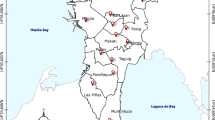Abstract
Based on the fact that the house dust usually falls on the ground, the floor level slit exhaust ventilation system including inlet located at the ceiling and outlet of slit exhaust installed at corner between wall and floor was considered. Experiments and simulations were performed to investigate the flow and diffusion fields that are affected by this floor level slit exhaust ventilation system. The characteristics of airflow with experiments and computation fluid dynamics (CFD) are generally similar except airflow at the location of impinging flow and the location right below the inlet. Riboflavin particles were used as the house dust. For the spatial distribution of riboflavin particles in the ventilation system before operation, due to the influence of gravity, different sizes of particles show smooth decay curve. After floor level slit exhaust ventilation system is operated, the decay rate of the particles becomes faster than that after the ventilation system is powered on, and the particles with diameter of 0.5–3.0 μm in the experimental data and calculated values show good agreement.
Similar content being viewed by others
References
PEARCEA N, PEKKANENA J, BEASLEYA R. How much asthma is really attributable to atopy? [J]. Thorax, 1999, 54: 268–272.
PAJNO G B, BARBERIO G, de LUCA F, MORABITO L, PARMIANI S. Prevention of new sensitizations in asthmatic children monosensitized to house dust mite by specific immunotherapy. A six-year follow-up study [J]. Clinical & Experimental Allergy, 2001, 31: 1392–1397.
BORNEHAG C G, SUNDELL J, SIGSGAARD T. Dampness in buildings and health (DBH): Report from an ongoing epidemiological investigation on the association between indoor environmental factors and health effects among children in Sweden [J]. Indoor Air, 2004, 14: 59–66.
RUNESON R, WAHLSTEDT K, WIESLANDER G, NORBÄCK D. Personal and psychosocial factors and symptoms compatible with sick building syndrome in the Swedish workforce [J]. Indoor Air, 2006, 16: 445–453.
SOMERVILLE M, MACKENZIE I, OWEN P, MILES D. Housing and health: does installing heating in their homes improve the health of children with asthma? [J]. Public Health, 2000, 114: 434–439.
THORN J, BRISMAN J, TORNE K. Adult-onset asthma is associated with self-reported mold or environmental tobacco smoke exposures in the home [J]. Allergy, 2001, 56: 287–292.
XI J X, SI X H, KIM J W. Simulation of airflow and aerosol deposition in the nasal cavity of a 5-year-old child [J]. Journal of Aerosol Science, 2011, 42(3): 156–173.
MURAKAMI S, KATO S, NAGANO S, TANAKA Y. Diffusion characteristics of airborne particles with gravitational settling in a convection-dominant indoor flow field [J]. Ashrae Transactions, 1992, 98(1): 82–97.
BOUILLY J, LIMAM K, BEGHEIN C. ALLARD F. Effect of ventilation strategies on particle decay rates indoors: an experimental and modeling study [J]. Atmospheric Environment, 2005, 39: 4885–4892.
GAO Nai-ping, NIU Jian-lei. Modeling particle dispersion and deposition in indoor environments [J]. Atmospheric Environment, 2007, 41: 3862–3876.
GAO Nai-ping, NIU Jian-lei, LIDIA M. Distribution characteristics of respiratory aerosols in enclosed environments [J]. Journal of Southeast University: English Edition, 2010, 26(2): 232–237.
ZHAO Bin, WU Jun. Effect of particle spatial distribution on particle deposition in ventilation rooms [J]. Journal of Hazardous Materials, 2009, 170: 449–456.
WATANABE R. Effects of heating systems on scattering of Der 1 based on experiments and CFD analysis [J]. Architectural Institute of Japan, 2006: 887–888. (in Japanese)
YOSHIKAWA M. Indoor pollution and allergy [M]. Tokyo, Japan: Inoueshoin Press, 1999: 37. (in Japanese)
Author information
Authors and Affiliations
Corresponding author
Additional information
Foundation item: Project supported by Ministry of Land, Infrastructure, Transport and Tourism of Japan; Project(DUT10RC(3)103) supported by the Fundamental Research Funds for the Central Universities in China; Project(20111027) supported by the Liaoning Provincial Scientific Research Foundation, China; Key Project (2012BAJ02B05) supported by the Twelfth Five-Year National Technology Program of China; Project supported by Dalian Municipal Construction Technology Program, China
Rights and permissions
About this article
Cite this article
Lü, Y., Yoshino, H., Takaki, R. et al. Effect of floor level slit exhaust ventilation system on distribution of house dust. J. Cent. South Univ. Technol. 19, 696–702 (2012). https://doi.org/10.1007/s11771-012-1059-5
Received:
Accepted:
Published:
Issue Date:
DOI: https://doi.org/10.1007/s11771-012-1059-5




